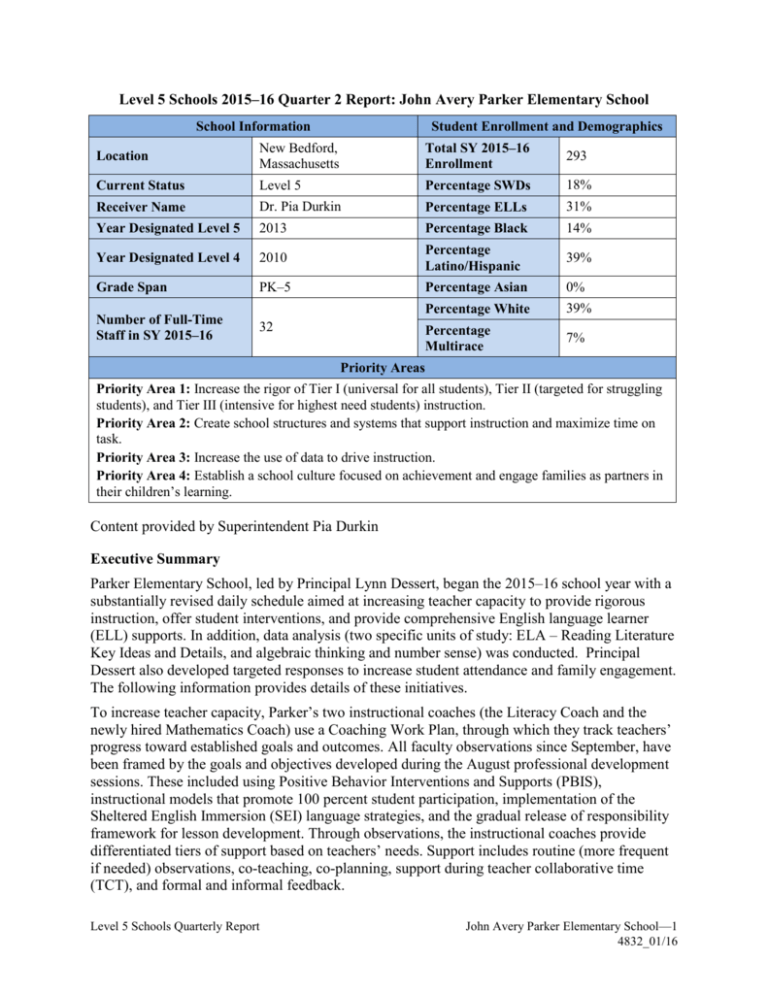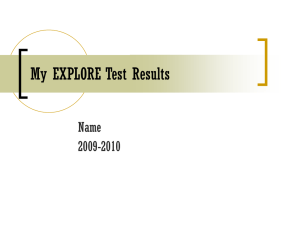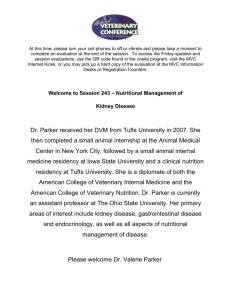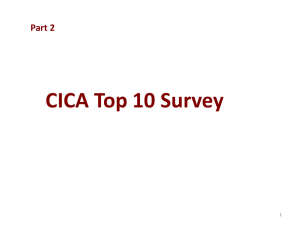Updates on Priority Areas - Massachusetts Department of Education
advertisement

Level 5 Schools 2015–16 Quarter 2 Report: John Avery Parker Elementary School School Information Student Enrollment and Demographics Location New Bedford, Massachusetts Total SY 2015–16 Enrollment 293 Current Status Level 5 Percentage SWDs 18% Receiver Name Dr. Pia Durkin Percentage ELLs 31% Year Designated Level 5 2013 Percentage Black 14% Year Designated Level 4 2010 Percentage Latino/Hispanic 39% Grade Span PK–5 Percentage Asian 0% Percentage White 39% Percentage Multirace 7% Number of Full-Time Staff in SY 2015–16 32 Priority Areas Priority Area 1: Increase the rigor of Tier I (universal for all students), Tier II (targeted for struggling students), and Tier III (intensive for highest need students) instruction. Priority Area 2: Create school structures and systems that support instruction and maximize time on task. Priority Area 3: Increase the use of data to drive instruction. Priority Area 4: Establish a school culture focused on achievement and engage families as partners in their children’s learning. Content provided by Superintendent Pia Durkin Executive Summary Parker Elementary School, led by Principal Lynn Dessert, began the 2015–16 school year with a substantially revised daily schedule aimed at increasing teacher capacity to provide rigorous instruction, offer student interventions, and provide comprehensive English language learner (ELL) supports. In addition, data analysis (two specific units of study: ELA – Reading Literature Key Ideas and Details, and algebraic thinking and number sense) was conducted. Principal Dessert also developed targeted responses to increase student attendance and family engagement. The following information provides details of these initiatives. To increase teacher capacity, Parker’s two instructional coaches (the Literacy Coach and the newly hired Mathematics Coach) use a Coaching Work Plan, through which they track teachers’ progress toward established goals and outcomes. All faculty observations since September, have been framed by the goals and objectives developed during the August professional development sessions. These included using Positive Behavior Interventions and Supports (PBIS), instructional models that promote 100 percent student participation, implementation of the Sheltered English Immersion (SEI) language strategies, and the gradual release of responsibility framework for lesson development. Through observations, the instructional coaches provide differentiated tiers of support based on teachers’ needs. Support includes routine (more frequent if needed) observations, co-teaching, co-planning, support during teacher collaborative time (TCT), and formal and informal feedback. Level 5 Schools Quarterly Report John Avery Parker Elementary School—1 4832_01/16 To improve student interventions, two intervention teachers were hired to implement tiered instruction. With support from the intervention teachers, each grade level assigns students to tiers that increase with intensity according to students’ needs on English language arts (ELA) and mathematics standards as identified by assessment data (e.g., Galileo, DRA, DIBELS, and district measures). During daily one-hour sessions, small groups of students are provided targeted instruction in both ELA and mathematics by classroom teachers, special education teachers, and the interventionist teachers. In addition, the Family Resource Manager focuses on increasing student attendance and family and community engagement. Based on an analysis of student attendance and family engagement data, targeted support is offered to students who have higher absenteeism and are at risk of becoming chronically absent. To intensify ELL supports, SEI language strategies are embedded into all classrooms, and a fulltime ELL teacher provides targeted support to the ELL students identified by the ACCESS testing. One hundred total ELL students are being served: 20 are receiving push-in support as they are levels 4 and 5, and 80 ELL students who are levels 1, 2, or 3 receive pull-out supports. New Bedford Public Schools’ Turnaround Manager resigned on November 23, 2015 and left the district on December 4, 2015. Moving forward, the Turnaround Manager’s responsibilities will be shared among the Superintendent, Chief Academic Officer, and Director of Supplemental Services. Updates on Priority Areas Priority Area 1: Increase the rigor of Tier I, Tier II, and Tier III instruction. Highlight: Each grade level has grouped students together on the basis of their level (or tier) of need using ELA and mathematic assessments (e.g., Galileo, DRA2, and a district formative assessment). In small groups, students participate in a one-hour ELA and onehour mathematics intervention called PRIDE time. PRIDE time is led by classroom teachers, interventionists, and special education teachers. Highlight: Teachers receive ongoing coaching from two instructional coaches. Each teacher and coach collaboratively develop a coaching plan for groups and individual teachers, and support is focused on making progress toward the goals established in these plans. Instructional coaches provide support to all teachers, with those with greater needs receiving more intensive and frequent support. Highlight: Professional development sessions focused on behavior management and increasing student engagement (targeting ELL students) are consistently planned throughout the school year. The selection of these topic areas is in direct response to needs identified by teachers in an end-of-year staff survey as well as needs identified by administration through benchmark assessments and the Schoolwide Instructional Observation Report, which provides data based on classroom observations that are a part of the Monitoring Site Visit process. Specifically, professional development focuses on: using the SEI strategies, PBIS, and the gradual release model of instruction. Highlight: Since September, classroom observations have been conducted a minimum of twice monthly for each teacher. Observations focus on providing growth-producing feedback and next steps regarding implementation of the initiatives developed during Level 5 Schools Quarterly Report John Avery Parker Elementary School—2 professional development. Positive changes in instructional practice have been noticed during district liaison learning walks and formal observations. Challenge: Meeting the social and behavior needs of younger students in the additional Pre-K classroom has been a challenge at times. The Family Resource Manager and Behavioral Interventionist are both in the classroom and working with families to meet these needs. Challenge: Unexpected staff departures, parent needs, and student needs have caused some scheduling interruptions. A new schedule and staffing adjustments have allowed the operations of the school to continue with only minor disruptions. In addition, strengthened systems for supporting students and families help address these unexpected needs when they arise. Priority Area 2: Create school structures and systems that support instruction and maximize time on task. Highlight: Two interventionists were hired to provide academic interventions to students. The schedule was revised to allow students in all grade levels to participate in this intervention time. At each grade level, students are assessed and determined to be above-level, on-level, below-level, or intensive, and placed into small groups based on these determinations. Data are collected and reanalyzed monthly to regroup students according to progress (data from Cycle 1 assessment attached). Highlight: An additional fifth-grade teacher was hired to accomodate the larger cohort of fifth-grade students during the 2015–16 school year. In addition, a full-time mathematics coach was hired and is supporting teachers in developing their classroom practice and increasing the rigor and quality of mathematics instruction. Highlight: A special education teacher was hired for grades 2–3 (identified as a challenge in the previous quarterly report). The delay in hiring the special education teacher created a burden for the school, but the principal wanted to ensure that the teacher had the qualifications to meet the needs of Parker’s students. Challenge: With only one ELL teacher, flexible scheduling is necessary to provide uninterrupted literacy instruction to those students requiring ELL instruction. At times it can be a scheduling challenge to uphold the commitment Parker made to keep all students in their core instruction while also providing needed supplemental supports. The principal has continued to review and refine the schedule as necessary to accommodate the needs of our ELLs and students with special needs. Priority Area 3: Increase the use of data to drive instruction. Highlight: There are established assessments for both ELA and mathematics to provide valid and timely data on students’ progress. The literacy coach, the mathematics coach and principal maintain a schoolwide database of student progress and indicators. This database is shared with the school’s liaison to the district’s Office of Instruction (the Manager of Curriculum, Data, and Assessment) and superintendent/receiver to communicate progress. Level 5 Schools Quarterly Report John Avery Parker Elementary School—3 Highlight: Weekly teacher collaboration time is dedicated to the analysis of student data. Teachers participate in grade-level teams and meet with both the ELA and mathematics instructional coaches and the principal to examine data from benchmark assessments. These data are specifically analyzed to monitor progress of groups of students and individual students toward extablished schoolwide standards and goals. During these conversations, plans for classroom and targeted student instruction are made in order to meet priority goals. Highlight: Using data from classroom observations and student assessment results, individual teachers are provided with targeted coaching support to develop instruction that meets students’ needs. The use of the six-week coaching cycle workplan allows coaches and teachers to collect data to monitor progress toward goals, within established time periods. Highlight: To enhance the consistency of teachers’ use of students’ formative assessment data throughout the school and improve the efficiency with which teachers are able to use data to inform decisions about students, Parker staff have developed and use individual student data folders, which are maintained by teachers. Challenge: At the beginning of the year, teachers were struggling to meet the weekly deadline (each Tuesday) for entering student data into the system. In turn, this impeded the ability of teachers, coaches, and the school leader to access updated student data during the teacher collaboration time and to make data-driven decisions about student needs. As teachers have developed their capacity and skills to use the data system and are understanding the value of the student data, more teachers are meeting the deadline and actively using the data. Priority Area 4: Establish a school culture focused on achievement and engage families as partners in their children’s learning. Highlight: Positive Behavior Interventions and Supports (PBIS) is now being implemented schoolwide. Teachers are provided ongoing professional development in PBIS. Each professional development session since August has been focused on using the PBIS model to increase student achievement. The impact of PBIS training is being measured by reviewing specific “look-fors” in classroom instruction being observed during learning walks and formal observations. Highlight: A system for collecting data on specific behaviors has been developed. Office referrals are being collected and analyzed as a means of monitoring patterns and trends in student behavior. Highlight: A schoolwide uniform initiative is now fully in place. Beginning on November 1, all Parker Scholars are expected to wear the Whaler Wear as described in the Parker handbook. Support has been provided to families through the Family Resource Manager to ensure access to uniform pieces. Highlight: Individualized family supports are provided to stabilize families in the areas of food, shelter, medical needs, and employment. At-risk families are being connected with school-based counseling. Between September 1 and November 30, 45 high-need Level 5 Schools Quarterly Report John Avery Parker Elementary School—4 families were provided stabilization referrals and services. There are also monthly formal check-ins, and informal conversations are daily and ongoing. Highlight: Family engagement is increasing during the second quarter. Parker continues to hold monthly coffee hours open to community members and parents. Four parents are serving as parent ambassadors who help to run the Family Resource Center, greet parents when they enter Parker, run community forums, and volunteer in the classrooms. Volunteers have increased from eight to 25. The school also hosted the first trimester Community Shout Outs to celebrate student achievement and increase family involvement. Highlight: Parker continues efforts to engage students’ families in learning. On November 24, Parker hosted a Literacy Night aimed at offering parents strategies to support literacy at home, which was attended by 41 families. In addition, Parker provided a workshop to share information with parents about how to use parent-teacher conferences to learn about and support student progress. Attendance at PTO meetings has increased greatly from one member last school year to 11 families who now attend monthly meetings. Challenge: A number of students have families whose own needs at times impede the students’ engagement in school. Parker is attempting to schedule home visits for families with such needs and develop comprehensive wraparound support for families through the development of a Family and Community Together with Schools (FACTS) team, which will engage the Department of Children and Families (DCF), mental health providers, youth and family service agencies and Parker faculty. Level 5 Schools Quarterly Report John Avery Parker Elementary School—5








